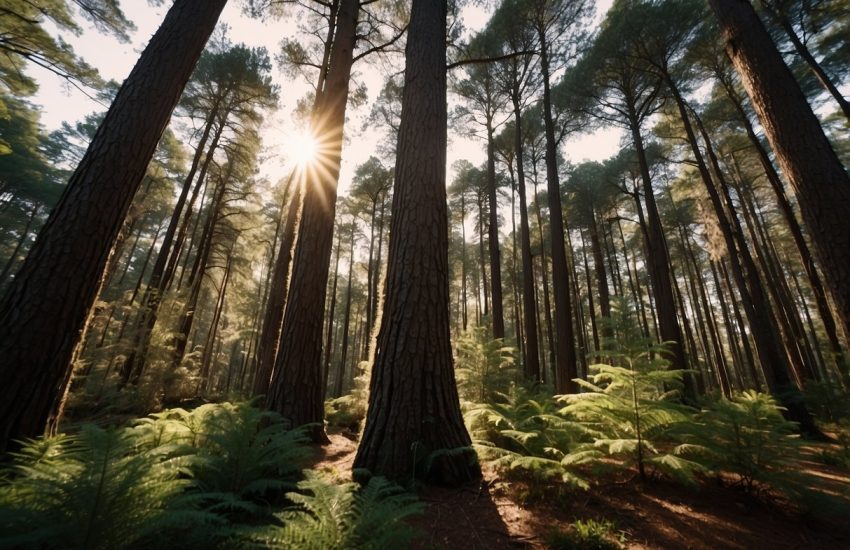How Tall Do Cypress Trees Grow
Towering cypress trees have always fascinated humankind because they symbolize strength, longevity, and resilience. Imagine standing underneath a cypress behemoth of a tree, gazing in awe at its soft, feathery, evergreen foliage that seems to touch the heavens. One can’t help but wonder: How tall do these magnificent cypresses truly grow?
Cypress trees are a beautiful addition to any landscape, commanding attention due to their sheer size, majestic height, and evergreen foliage. If you’re considering planting cypress trees and wondering how tall they can grow, you’ve come to the right place. This article is your comprehensive guide, with a detailed overview of cypress trees, including their height, different species, and tips for growing them. We will also explore the factors that influence the height of cypress trees, and at the end, leave you a better idea of just how tall they can get.
What is a Cypress Tree?
Cypress trees belong to the magnificent group of conifers, distinguished by their needle-like leaves and distinctive bark, and are classified within the plant family Cupressaceae. These majestic trees are evergreen, with lush foliage that remains vibrant green throughout the year. Many cypress species naturally take on a graceful conical shape, with branches elegantly reaching skyward from the trunk.
The leaves of cypress trees start as spreading and awl-shaped on young shoots, but as the tree matures, they transform into small, scale-like structures that closely hug the branches. Different species exhibit varied leaf structures, with some featuring scale-like leaves like the Italian Cypress (Cupressus sempervirens), while others, like the Bald Cypress (Taxodium distichum), have needle-shaped leaves. These unique leaf adaptations allow cypress trees to thrive in diverse climates and play a vital role in photosynthesis and water conservation.
Cypress tree bark is often thick and fibrous, serving as a protective shield against external threats such as fire and pests. In many species, the bark separates into thin plates or strips that may be shed from the tree, aiding in nutrient recycling. Additionally, every cypress tree boasts a robust root system that firmly anchors it to the ground while absorbing water and vital nutrients from the soil. Different species have developed various root adaptations, such as horizontal buttressing roots, to provide stability in various terrains.
Instead of producing fruits, cypress trees reproduce through cones that house seeds. The male cones release pollen, fertilizing the female cones, and as the cones mature, they disperse seeds that eventually germinate into new cypress trees. These trees showcase remarkable diversity, from the iconic Italian Cypress (Cupressus sempervirens) of the Mediterranean to the Bald Cypress (Taxodium distichum) found in southeastern swamps. They display a wide geographic distribution, with various species thriving in different regions around the world.
How Tall Do Cypress Trees Grow
Cypress trees are known for their impressive height, and some species are among the tallest trees in the world. For example, a newly discovered Himalayan cypress growing in Tibet is now the tallest known tree in Asia, towering 335 feet above the forest floor. Cypress trees can vary in height depending on the species, climate, and care they receive, but in general, cypress trees can grow anywhere from 20 to 100 feet tall.
Here are our top five cypress species and their accompanying features, growth habits, and heights ideally suited for flourishing in your garden:
Gowen Cypress (Cupressus goveniana)
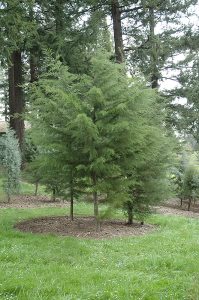
Gowen cypress, or Californian cypress, is a cypress species native to the central coast of California, United States. It is often found growing in sandy or rocky soils, particularly in areas with coastal fog influence, and can reach heights up to 50 feet. It has spreading bent branches, a flat-topped crown with scale-like leaves arranged in whorls of four. Gowen cypress is often cultivated as an ornamental tree in gardens and landscapes and is appreciated for its unique appearance and adaptation to coastal climate.
Monterey Cypress (Cupressus macrocarpa)

Monterey Cypress is a fast-growing, large evergreen conifer with a narrow and pyramidal habit in its youth. The tree has a narrow or broadly conical shape when young, but it becomes broadly spreading with age. It is native to the United States and, in ideal growing conditions, can reach heights of up to 40 meters (133 feet) with a trunk diameter of over 2.5 meters (8 feet). The foliage of Monterey Cypress grows in dense sprays that are bright green and release a deep, lemony aroma when crushed. The tree bark starts as red-brown and then turns gray, becoming furrowed with age. Monterey Cypress is known for its ability to withstand strong winds, which can result in an irregular and flat-topped growth form.
Nootka Cypress (Cupressus nootkatensis)
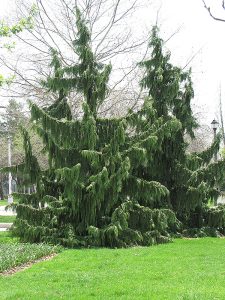
Nootka cypress, commonly known as Alaska cypress or Alaska yellow cedar, is a species of cypress native to the coastal regions of northwestern North America, particularly in Alaska and western Canada. It can grow up to 40-60 meters (130-200 feet) tall and has a conical shape. The tree’s bark is thin, scaly, and reddish-brown with scale-like, 2-4 mm long leaves arranged in opposite pairs along the stem. It has graceful pendulous branches that upsweep at the tips, producing small, round cones that turn brown when mature and release winged seeds.
Leyland Cypress (Cupressus leylandii)
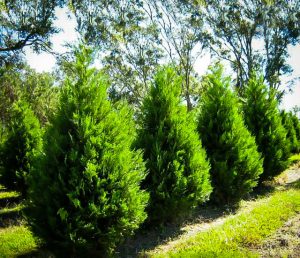
The Leyland cypress is a fast-growing hybrid tree that results from the cross between the Monterey cypress (Cupressus macrocarpa) and the Nootka cypress (Chamaecyparis nootkatensis). It has become a popular choice for landscaping and is widely planted for its rapid, wide growth and dense foliage in the form of a pyramid. It can grow to impressive heights, ranging from 50 to 100 feet (15 to 30 meters). The foliage consists of soft, scale-like leaves that form flat sprays with color that ranges from dark to bright green.
Italian Cypress (Cupressus sempervirens)
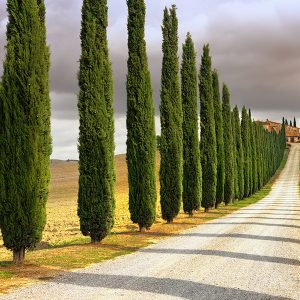
Italian Cypress, commonly known as Mediterranean cypress, is a cypress tree native to the eastern Mediterranean region. It is a tall, slender tree with a narrow, columnar shape and dense, dark green foliage that can reach 70 to 100 feet (21 to 30 meters) or more. The tree’s bark is grayish-brown and becomes fissured with age, and the leaves are scale-like and arranged in flattened sprays, giving the tree a fine and delicate appearance. Due to its tall and narrow growth habit, the Italian cypress is commonly used as an ornamental tree and is often planted in Mediterranean landscapes, gardens, and historical sites.
Factors that Affect the Height of Cypress Trees
Cypress trees have adapted to different climates in various ways to thrive in their respective environments. While they prefer dry, hot summers and mild winters, they can also tolerate colder climates. Some species of cypress trees, such as the Arizona Cypress, are adapted to hot and dry conditions and have developed mechanisms to conserve water and withstand prolonged periods of drought. Other cypress species, like the Bald Cypress, are well-adapted to wet conditions along riverbanks and swamps and have developed adaptations to thrive in waterlogged soils.
Despite all the adaptive features, certain factors affect the height of most cypress trees, and some of the notable ones are:
- Temperature: Temperature affects tree growth and metabolism, and cypress trees often flourish in regions with mild climates, where temperature extremes are less likely to hinder growth. Such environments provide optimal conditions for sustained growth throughout the year. In colder regions, cypress trees may experience slower growth during winter.
- Precipitation: Precipitation is vital in supporting cypress tree growth, even though most species are drought tolerant. Adequate water availability is crucial for root development, nutrient uptake, and photosynthesis. However, excessive waterlogged conditions can be detrimental, leading to root rot and limiting oxygen availability to the roots.
- Soil type: Cypress trees are relatively adaptable to various soil types but prefer well-draining soil. Sandy or loamy soils with good drainage allow the roots to access water and nutrients effectively. Conversely, clayey or compacted soils can hinder root growth, resulting in stunted tree height. The pH of the soil also influences cypress tree growth. Most species prefer slightly acidic to neutral soil conditions. Alkaline soils can affect nutrient availability, potentially impacting tree health and height.
- Genetics: The growth potential of different cypress tree species is significantly influenced by genetic factors. Each species possesses unique genetic traits that shape their growth patterns, size, and overall characteristics. Certain cypress species have a genetic predisposition to attain greater heights than others. For instance, the Giant Sequoia (Sequoiadendron giganteum) has genetic traits that allow it to grow exceptionally tall.
- Habitats: Cypress trees can grow in various habitats, including swamps, marshes, and even deserts, but prefer habitats with moist, well-drained soil. Those in such habitats will be taller than cypress trees that grow in habitats with less favorable conditions. But Certain cypress species, like the Bald Cypress (Taxodium distichum) and the Montezuma Cypress (Taxodium mucronatum), thrive in wetland environments like swamps and marshes. These habitats provide nutrient-rich soils and consistent water availability, supporting vigorous growth and facilitating their ability to attain remarkable heights.
Tips and Guidelines For Growing Cypress Trees
Most cypress tree species are very easy to care for and grow quite quickly when planted correctly, hence their popularity. They are naturally insect repellants, adaptable in most climates, and grow well in most soils. But growing healthy cypress trees depends on following certain guidelines to ensure they bloom to your desired taste. Some of the notable tips and general guidelines you should follow when planting your cypress tree include:
Select a cypress tree species that suit your garden’s size and climate. Some species, like the Leyland Cypress, grow fast and are ideal for creating screens and privacy hedges. In contrast, others, like the Italian Cypress, have a more vertical growth form, making them suitable as elegant focal points.
Choose the right planting location in your garden or hedge, preferably one with good sunlight (at least eight hours of sunlight per day). This area should have well-drained soil, as most cypress tree species grow well in these soil structures. Cypress trees prefer damp to moist soil but do not like constantly soggy or wet conditions.
Consider the mature size of the cypress tree when spacing them in your garden. Leave enough room for the tree to grow without crowding other plants or structures.
Dig a hole twice as wide and as deep as the root ball of the cypress tree; this will provide enough space for the root to spread out.
Place the cypress tree in the hole, making sure the base of the tree is 1 to 2 inches above the soil level. Backfill the hole halfway and wet it with enough water before filling the rest of the soil.
Tamp down on the soil gently to remove air pockets and give the newly planted cypress tree a deep watering immediately after planting. Afterward, water regularly for the first few months until the tree is well established. Once established, cypress trees are generally drought-tolerant.
Apply a layer of organic mulch around the tree’s base, but avoid piling it against the trunk. Mulch helps retain soil moisture, suppress weeds, and protect the roots from temperature fluctuations.
Cypress trees are not heavy feeders but can benefit from fertilization, especially when young. In the following spring, after planting, you can apply a balanced fertilizer with a ratio of 10-10-10 to support the growth and overall health of the tree.
Cypress trees are generally low-maintenance, but regular care is still important. Prune in late winter or early spring before new growth begins, and prune any dead or damaged branches as needed. Regular pruning helps manage height and spread, preventing potential conflicts with structures or other vegetation. Proper pruning techniques also promote healthy growth and reduce the risk of limb breakage during storms.
Cypress trees are not primary targets for pests, but aphids and scale can be problematic. Treat the tree with a natural pesticide like neem oil, and organic sprays, such as natural pyrethrum or plant oils, can also be used.
Final Thoughts
Cypress trees have a special place in cultural and environmental narratives due to their towering presence and myriad benefits. They are decorative, with little maintenance needed, and are an immensely popular choice for landscaping due to their rapid growth and remarkable ability to thrive in poor soils. This exceptional resilience makes them highly effective in creating privacy screens, barriers, and windbreaks. Understanding the growth habits of these trees can help you plan your landscaping and ensure that you have a firm idea of just how tall the various cypress species can get.


